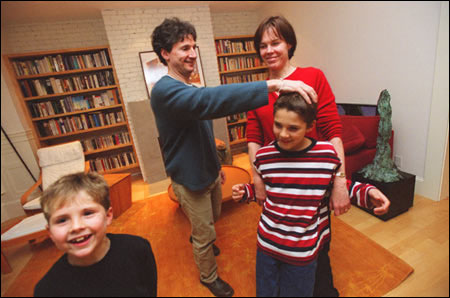Kahne brings chemistry to life
Professor bridges biology and chemistry

Daniel Kahne is not so much a self-made man as a mentor-made man.
Mentors brought him back to college when he dropped out, taught him the joy of research, and gave him the idea of solving some of life’s biological problems with the help of chemistry.
Harvard brought him here in July as a tenured professor of chemistry and chemical biology to do for others what others have done for him. He is here to develop and apply the tools of chemistry to questions like how do bacteria always manage to keep one evolutionary step ahead of all the scientists who are trying to kill them?
Kahne also will participate in a new Ph.D. program in chemical biology that bridges the scholarly and collegial gap between Harvard Medical School and the University’s departments of chemistry and molecular biology.
“I have no formal training in biology,” admits the 45-year-old professor. “But I have always been interested in questions related to biology and human health, and I can provide a different perspective from which to study these questions. I’m excited about the opportunities I’ll have to do this here.”
Christopher T. Walsh, Hamilton Kuhn Professor of Biological Chemistry and Molecular Pharmacology at the Medical School, is glad to have Kahne here. “Dan is deeply thoughtful as a scholar,” he says. “His creativity is in thinking deeply about molecular puzzles and inconsistencies and coming up with experimental approaches to resolve them. We have had a very productive collaboration on antibiotics, how bacteria become resistant to them, and what can be done to combat resistance with new drugs. Besides, he is also a serious Red Sox fan.”
Walsh also is a fan of Kahne’s wife, Suzanne Walker, who moved with him from the chemistry department at Princeton University. “Both are terrific people as well as front-rank scientists,” Walsh says. “She has an appointment as a professor of microbiology and molecular genetics at the Medical School. I have moved my labs to be her immediate neighbor, and we will be collaborating on a number of projects.”
Art history vs. chemistry
Raised in Lexington, Mass., Kahne comes from an academic family with ties to Harvard. After a long career as a professor at MIT, his father lectured in social psychiatry at Harvard Medical School from 1969 to 1973. His mother received a Ph.D. in labor economics from Harvard in 1953, then chaired the department of economics at Wheaton College in Massachusetts until she retired at age 70.
In high school, Kahne was curious enough about health issues to work summers in a research lab at Beth Israel Hospital in Boston. He also studied art and majored in art history at Cornell University, where he wrote a thesis on the Swiss impressionist Paul Klee.
Kahne dropped out of Cornell, but his adviser, Roald Hoffmann, didn’t drop out on him. “He could have said, ‘What the heck is your problem?’ Kahne recalls, “but he remained supportive. He made me visit him at his office every week, and suggested that I work in the chemistry lab of a young faculty member, Dave Collum.” Hoffmann himself had been an art history major and wound up winning a Nobel Prize in chemistry.
“I can’t recall any specific moment that I became interested in chemistry,” Kahne comments. “I think people find their way in life based in part on relationships with others. Hoffmann and Collum made it enjoyable to do research.”
This turned out to be true in graduate school, too. Kahne earned his Ph.D. and did postdoctoral work in chemistry at Columbia University between 1981 and 1988. “That was the happiest time of my life,” he recalls. “I met my wife, who was also graduate student, there, and I worked with world-class scientists who were also great teachers.”
With Gilbert Stork, his Ph.D. adviser, Kahne studied the structure of tetracycline. “Stork didn’t care that tetracycline was an antibiotic,” he says. “We didn’t discuss its biological activity. He wanted to learn how to build molecules of that complexity in a lab.”
Structure vs. function
As a postdoc at Columbia, Kahne worked with Clark Still, a man he describes as a “genius.” “Biologists tend to work with large molecules like DNA and proteins,” he notes. “Clark wanted to mimic some of the functions of natural large molecules with synthetic small ones. With him I began to think more about the functions of molecules, whereas before I had focused mainly on their structures.”
This focus on function came in handy when Kahne moved to an assistant professorship at Princeton. “I met a lot of molecular biologists there, and they encouraged me to think about problems on the interface of chemistry and biology,” he says.
Over the next 17 years, there was a national movement toward using chemistry to understand biology, and Kahne became part of it. “My wife and I decided to come to Harvard because of a strong interdisciplinary program that involves the commitment of outstanding scientists in chemistry, biology, and medicine.”
Kahne is also looking forward to preparing graduate and undergraduate students to travel this new road in chemistry. “There are so many exciting new things to learn here,” he says, “that I can be both a student and a mentor.”




